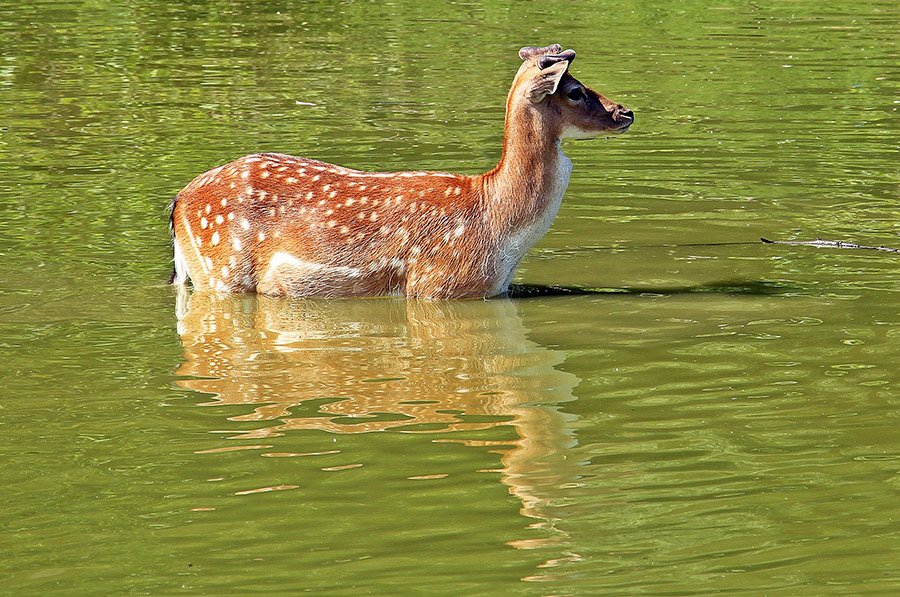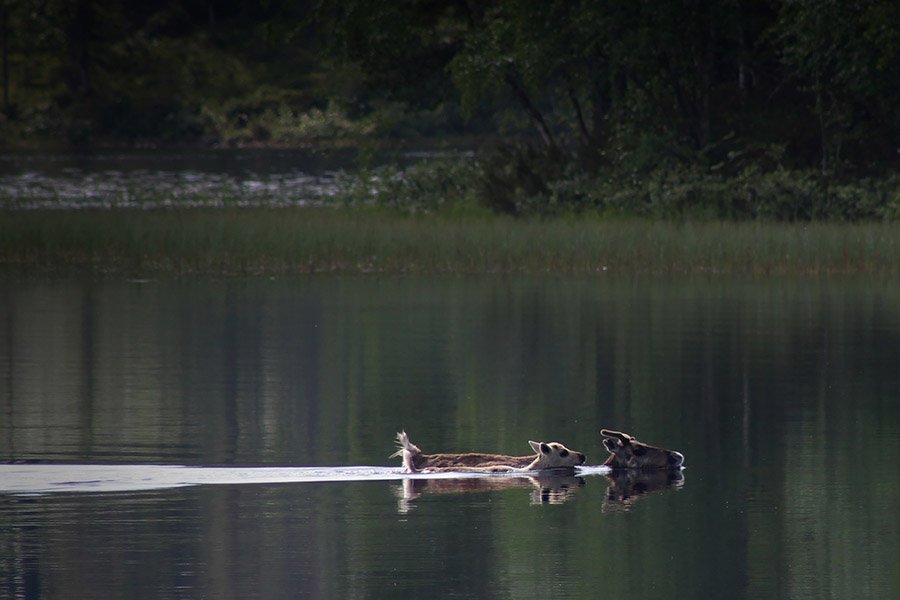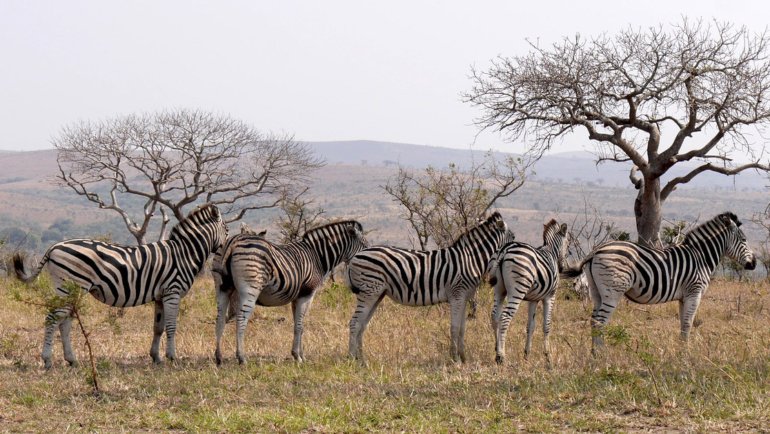Although deer are known for their elegance and swiftness on land, many wonder whether these mammals can swim.
Fortunately, this article will address this query comprehensively while exploring the adaptations that enable deer to swim and the factors that influence them to perform that act.
Can Deer Swim & Are They Good Swimmers?
Although these mammals are less skilled than most aquatic creatures, they possess the basic swimming skills and adaptations required to float, swim, and even cross various water bodies like rivers, ponds, dams, and smaller lakes. Therefore, it’s safe to conclude that deer are good swimmers.
For What Reasons Do Deer Get in Water and Swim?
These animals may get in the water and swim for various reasons, including:
1. Escaping Predators
When threatened by predators, such as wolves or coyotes, deer may get in the water as a way to escape. Swimming usually allows them to swiftly maneuver away from their attackers and seek refuge from the safer side of the water body.
2. Foraging for Food
These creatures are herbivores and need to eat various plants to survive. They may plunge across a body of water to access new food sources on the other side.
3. Exploring New Territory
Like many animals, deer may be curious and explore new areas in their habitat. Water can be a barrier to their movement, and swimming can allow them to cross over to new areas to explore.
4. Avoiding Harsh Weather Conditions
In extreme weather conditions, such as during a flood or wildfire, deer may have no choice but to swim to safety.
5. Migration
Some species (including deer) are known to migrate lengthy distances, and large water bodies, like rivers, are common obstacles in their natural habitat.
Fortunately, their ability to swim enables the deer living near rivers/lakes/ponds to cross them and seasonally migrate to their desired habitats effectively.

How Far Can a Deer Swim?
The ranges a deer can swim varies depending on various factors, such as the deer’s age, physical condition, the depth and size of the water body they are crossing, and the weather conditions.
However, studies have shown that an adult deer can swim up to 13 miles or 21 kilometers without stopping.
It’s important to note that while deer are good paddlers, long distances can be exhausting and potentially dangerous. They may become fatigued or be unable to find a safe exit point, putting them at risk of drowning.
How Fast Can a Deer Swim?
Deer can swim at an average speed of around 13-15 mph.
However, the speed varies depending on various factors, such as the deer species, the deer’s size, and the current’s strength. While this may not seem as fast as other aquatic animals, it is still a considerable speed for a land animal swimming in water.
Additionally, deer are known for their agility and quick movements on land, which can also help them navigate swiftly through shallow water bodies.
What Makes Deer Good Swimmers?
Below are three reasons which make these creatures great swimmers:
1. Physical Adaptations
Deer have long, slender legs and well-developed limb muscles that allow them to propel through waters and are also significantly powerful to enable them to swim against harsh currents.
Their light body weight and muscular legs also create a natural buoyancy that helps keep them afloat. Additionally, their dense waterproof fur helps them stay warm while in the water and prevents hypothermia conditions.

2. Natural Instincts
Deer have a strong survival instinct and are highly adaptable. Since swimming can help them escape predators or find new food sources, they have evolved and perfected their ability to adopt this skill when necessary.
3. Agility
Deer are known for their agility and quick movements on land, and these abilities also translate to the water.
Their ability to move quickly and change direction helps them navigate the water more efficiently, especially when wading through shallow water bodies.
Can Baby Deer Swim?
Baby deer, also known as fawns, can swim but are less skilled than adult deer. Fawns are born with a dense, waterproof coat of fur, which helps keep them afloat in the water.
However, they have yet to develop solid muscles or Agility like an adult deer, so their swimming ability is more limited. Fawns typically learn to swim by following their mothers, which helps them learn the basic skills they need to navigate the water.

The Water Deer: The Best Swimmer
Origin
The Water Deer is a small species of deer native to East Asia. These creatures are skilled swimmers and adapted to living in wetland environments.
Species
There are two recognized species of water deer which are:
1. Korean Water Deer:
This species is found in northeastern China and the Korean peninsula. It has a darker coat color and is generally more prominent than the Chinese Water Deer subspecies.
2. Chinese Water Deer
This subspecies is found in central and eastern China. It has a lighter coat color and is generally smaller than the Korean Water Deer subspecies.
About These Two Sub-Species
Since they are both adapted to living in wetland environments, they are typically found near rivers, streams, and marshes, where they can swim to find food and escape potential threats from predators.
The water deer are known for their ability to hold their breath for extended periods, allowing them to stay underwater for up to 30 seconds. They can also swim up to 6 miles per hour or 10 kilometers per hour and travel long distances through the water.
Frequently Asked Questions
Do Deer Swim in the Ocean?
Deer rarely swim in the ocean since they are not adapted to saltwater environments which are the typical conditions present in most oceans.
While these creatures are great paddlers, they are primarily found in terrestrial environments such as forests, meadows, and grasslands.
Can Deer Swim in Deep Water?
Yes, deer can effectively swim in deep water if necessary. Swimming is a typical means of transportation for deer, particularly when they must cross significant water bodies to reach new feeding grounds or escape predators.
Therefore, since these mammals are well adapted to swimming with their slender bodies and long legs providing good buoyancy and propulsion, they can also hold their breath for several minutes, allowing them to swim longer distances.
Can Deer Swim Underwater?
While these mammals can hold their breath for several minutes, they cannot swim underwater for a long time.
They may briefly submerge their heads to drink water or to feed on aquatic plants but cannot swim entirely underwater.
Can Deer Swim to Islands?
Deer are capable of swimming to islands if they are nearby and the water is not too deep. Deer are good swimmers and can swim several miles if necessary, although they typically prefer to avoid deep water if possible.
Sometimes, deer may swim to islands to access new food sources or escape predators. However, not all islands are accessible to these animals, as some may be too far away or surrounded by water that is too deep or dangerous for swimming.
Can Elk Swim?
Elk are well-adapted to swimming since their long legs enable them to propel forwards effectively, while their large body size provides sufficient buoyancy to help them float in water.
Can Reindeer Swim?
Reindeer are known to be strong paddlers and can swim long distances, even across large bodies of water. In their native habitat, reindeer may need to swim across rivers to reach new feeding grounds or escape predators.
They are well-adapted to swimming, with their thick fur providing insulation in cold water and their large hooves helping them navigate the water.
However, swimming can be risky for these mammals, especially if the water is cold or the current is strong. Therefore, they will swim only when necessary and will try to avoid risky crossings if possible.
How Fast Can Moose Swim?
Moose are excellent swimmers capable of swimming at a moderate pace. However, they are not known for their speed in the water, as they are relatively large and have a somewhat awkward swimming style.
The exact swimming speed of a moose can vary depending on factors such as the moose’s size, the water’s conditions, and the distance.
In general, an adult moose can swim at a speed of around 6 mph.
Final Thoughts
Deer are good swimmers able to maneuver across waters if necessary. However, swimming can be risky for deer, especially if the water is deep or the current is strong.
Therefore, they will typically only swim when necessary and try to avoid risky crossings if possible. Overall, while not their primary means of transportation, swimming is an essential survival skill for deer in the wild.



